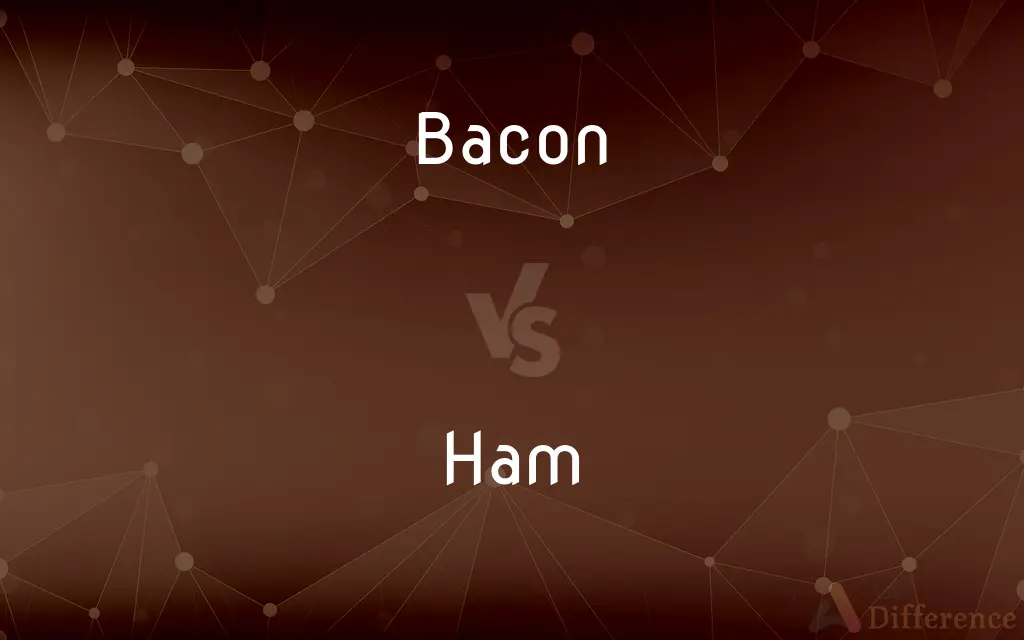Bacon vs. Ham — What's the Difference?
Edited by Tayyaba Rehman — By Urooj Arif — Updated on March 29, 2024
Bacon is a cured meat from the pork belly or back, known for its crispy texture when cooked, while ham is a cured leg of pork, appreciated for its juicy, tender quality.

Difference Between Bacon and Ham
Table of Contents
ADVERTISEMENT
Key Differences
Bacon is typically prepared from the pork belly or, less frequently, the back, undergoing a curing process with salt and often smoked for added flavor. It's celebrated for its rich, crispy texture when fried. Ham, on the other hand, comes from the pork's hind leg and undergoes a similar curing process but is usually sold cooked or smoked, known for its moist, tender texture and is often served in slices.
The curing process for bacon involves significant salt content and sometimes the addition of flavorings like maple or applewood smoke, resulting in a distinctive, savory flavor profile. Ham’s curing process can also include similar ingredients but often focuses on preserving the meat’s natural moisture and tenderness, occasionally enhanced with a glaze or seasoning for additional flavor.
Bacon is commonly used in a wide array of dishes, from breakfast items to burgers and salads, valued for its ability to add a crisp, savory note. Ham is versatile as well, often featured in holiday meals, sandwiches, and soups, providing a rich, meaty flavor without the crispness of bacon.
Nutritionally, both bacon and ham are sources of protein and fat, but bacon generally contains higher amounts of fat, contributing to its crispy texture when cooked. Ham, while still fatty, tends to offer a leaner option with a different nutritional profile, often containing more water content.
The cultural significance of both meats varies globally, with bacon often being a staple in American breakfast cuisine, symbolizing comfort and indulgence. Ham holds a place in many traditional cuisines, serving as the centerpiece for celebrations and family gatherings, embodying a sense of occasion and generosity.
ADVERTISEMENT
Comparison Chart
Part of Pork
Belly or back
Hind leg
Texture
Crispy when cooked
Moist and tender
Flavor
Savory, can be smoky or sweet
Rich, can be enhanced with glazes
Curing Process
Salted, sometimes smoked
Salted, sometimes smoked or glazed
Usage
Breakfast items, salads, burgers
Sandwiches, holiday meals, soups
Nutritional Content
Higher fat content
Lower fat, more water content
Cultural Significance
Associated with breakfast and indulgence
Central to celebrations and gatherings
Compare with Definitions
Bacon
Often smoked to enhance its savory taste.
The applewood-smoked bacon had a distinctive taste.
Ham
The leg of pork that has been cured, sometimes smoked.
We're having a glazed ham for dinner.
Bacon
Known for its crispy texture when cooked.
Crispy bacon is often the highlight of a brunch menu.
Ham
Known for its moist, tender quality.
The ham was so tender, it fell apart with a fork.
Bacon
Adds savory flavor to a variety of dishes.
She topped the salad with chopped bacon for extra flavor.
Ham
Can be enhanced with various glazes and seasonings.
The pineapple glaze gave the ham an excellent flavor.
Bacon
A key component in traditional American breakfasts.
Bacon and eggs are a classic breakfast pairing.
Ham
Used in sandwiches, soups, and more.
She made a hearty ham and bean soup for lunch.
Bacon
Thin slices of pork belly cured with salt.
He fried up some bacon for breakfast.
Ham
Often served at celebrations and gatherings.
The Christmas dinner featured a large, honey-glazed ham.
Bacon
Bacon is a type of salt-cured pork made from various cuts, typically from the pork belly or from the less fatty back cuts. It is eaten on its own, as a side dish (particularly in breakfasts), or used as a minor ingredient to flavour dishes (e.g., the club sandwich).
Ham
Ham is pork from a leg cut that has been preserved by wet or dry curing, with or without smoking. As a processed meat, the term "ham" includes both whole cuts of meat and ones that have been mechanically formed.
Bacon
The salted and smoked meat from the back and sides of a pig.
Ham
(in the Bible) a son of Noah (Gen. 10:1), traditional ancestor of the Hamites.
Bacon
Cured meat from the sides, belly, or back of a pig.
Ham
Overact
She hammed it up for the cameras
Bacon
Thin slices of the above in long strips.
Ham
The thigh of the hind leg of certain animals, especially a hog.
Bacon
The police or spies.
Run! It's the bacon!
Ham
A cut of meat from the thigh of a hog, often cured by salting or smoking.
Bacon
Road rash.
Ham
The back of the knee.
Bacon
A saucisse.
Ham
The back of the thigh.
Bacon
The back and sides of a pig salted and smoked; formerly, the flesh of a pig salted or fresh.
Ham
Hams The buttocks.
Bacon
Roger Bacon. A celebrated English philosopher of the thirteenth century. Born at or near Ilchester, Somersetshire, about 1214: died probably at Oxford in 1294. He is credited with a recognition of the importance of experiment in answering questions about the natural world, recognized the potential importance of gunpowder and explosives generally, and wrote comments about several of the physical sciences that anticipated facts proven by experiment only much later.
The Franciscan monk, Roger Bacon (c. 1214 - 1294) was an important transitional figure in chemistry as he was trained in the alchemical tradition, but introduced many of the modern concepts of experimental science. Bacon believed that experiment was necessary to support theory, but for him the theory as presented in the Bible was true and the experiment only underlined that truth. One of Bacon's lasting contributions was his references to gunpowder, bringing this discovery to the general attention of literate Europeans. Gunpowder had been known for centuries in China, being used for fireworks and incendiary grenades. Gunpowder is a simple mixture of charcoal, sulfur, and potassium nitrate (known generally as saltpeter). Saltpeter is a major component of guano (bird droppings) and may be recovered from privies where it will crystallize. By 1324, Europeans had discovered the art of using gunpowder to fire a projectile, marking the end of the period of castles and knights in armor.
Roger Bacon was Born at or near Ilchester, Somersetshire, about 1214: died probably at Oxford in 1294. He was educated at Oxford and Paris (whence he appears to have returned to England about 1250), and joined the Franciscan order. In 1257 he was sent by his superiors to Paris where he was kept in close confinement for several years. About 1265 he was invited by Pope Clement IV. to write a general treatise on the sciences, in answer to which he composed his chief work, the "Opus Majus." He was in England in 1268. In 1278 his writings were condemned as heretical by a council of his order, in consequence of which he was again placed in confinement. He was at liberty in 1292. Besides the "Opus Majus," his most notable works are "Opus Minus," "Opus Tertium," and "Compendium Philosophiae." See Siebert, "Roger Bacon," 1861; Held, "Roger Bacon's Praktische Philosophie," 1881; and L. Schneider, "Roger Bacon," 1873.
Dr. Whewell says that Roger Bacon's Opus Majus is "the encyclopedia and Novam Organon of the Thirteenth Century, a work equally wonderful with regard to its general scheme and to the special treatises with which the outlines of the plans are filled up.
Ham
A performer who overacts or exaggerates.
Bacon
Back and sides of a hog salted and dried or smoked; usually sliced thin and fried
Ham
A licensed amateur radio operator.
Bacon
English scientist and Franciscan monk who stressed the importance of experimentation; first showed that air is required for combustion and first used lenses to correct vision (1220-1292)
Ham
To exaggerate or overdo a dramatic role; overact.
Bacon
English statesman and philosopher; precursor of British empiricism; advocated inductive reasoning (1561-1626)
Ham
To exaggerate or overdo (a dramatic role, for example).
Ham
(anatomy) The region back of the knee joint; the popliteal space; the hock.
Ham
(countable) A thigh and buttock of an animal slaughtered for meat.
Ham
(uncountable) Meat from the thigh of a hog cured for food.
A little piece of ham for the cat
Ham
The back of the thigh.
Ham
Electronic mail that is wanted; mail that is not spam or junk mail.
Ham
Obsolete form of home
Ham
(acting) An overacting or amateurish performer; an actor with an especially showy or exaggerated style.
Ham
(radio) An amateur radio operator.
Ham
(acting) To overact; to act with exaggerated emotions.
Ham
Home.
Ham
The region back of the knee joint; the popliteal space; the hock.
Ham
The thigh of any animal; especially, the thigh of a hog cured by salting and smoking.
A plentiful lack of wit, together with most weak hams.
Ham
A person who performs in a showy or exaggerated style; - used especially of actors. Also used attributively, as, a ham actor.
Ham
The licensed operator of an amateur radio station.
Ham
To act with exaggerated voice and gestures; to overact.
Ham
Meat cut from the thigh of a hog (usually smoked)
Ham
(Old Testament) son of Noah
Ham
A licensed amateur radio operator
Ham
An unskilled actor who overacts
Ham
Exaggerate one's acting
Common Curiosities
Why is bacon often associated with breakfast?
Bacon's rich, savory flavor and crispy texture make it a favored choice for breakfast, complementing eggs and other morning dishes.
What is the primary difference between bacon and ham?
The primary difference lies in their origin on the pig and their texture; bacon is from the belly or back and is crispy, while ham is from the hind leg and is tender.
Is ham healthier than bacon?
Ham can be considered a leaner option with more water content and less fat compared to bacon, making it a slightly healthier choice for some.
Are there different types of bacon?
Yes, there are several types of bacon, including American-style, Canadian bacon, and pancetta, differing in cut and preparation.
Can bacon be eaten without cooking?
No, bacon needs to be cooked to ensure it's safe to eat and to achieve its characteristic crispy texture.
Is bacon always made from pork?
While traditional bacon is pork-based, there are alternatives like turkey bacon for those avoiding pork.
What dishes are bacon and ham commonly used in?
Bacon is used in breakfast dishes, salads, and sandwiches, while ham is common in holiday meals, soups, and sandwiches.
How are bacon and ham similar?
Both are cured pork products and can be smoked for added flavor, making them savory meat options in various dishes.
What are the most popular ways to cook bacon?
Bacon is most commonly fried, but it can also be baked, grilled, or cooked in a microwave.
What are some common seasonings for ham?
Ham can be glazed with honey, brown sugar, mustard, or fruit-based glazes, among others, to enhance its flavor.
How should leftover ham be stored?
Leftover ham should be refrigerated and is best consumed within 3-5 days, or it can be frozen for longer storage.
Can ham be served raw?
While "raw" ham is actually cured and sometimes smoked (making it safe to consume, like prosciutto), most ham is cooked or baked before serving, especially when it's part of a holiday meal.
How can ham be prepared for a holiday meal?
Ham can be baked with a glaze of choice, scored, and sometimes studded with cloves or pineapple, serving as a festive centerpiece.
Can ham be smoked like bacon?
Yes, ham can also be smoked, a process that adds depth to its flavor profile.
Why is bacon considered unhealthy?
Bacon's high fat and sodium content can contribute to health issues when consumed in excess.
Share Your Discovery

Previous Comparison
Ophidian vs. Serpentine
Next Comparison
Review vs. PreviewAuthor Spotlight
Written by
Urooj ArifUrooj is a skilled content writer at Ask Difference, known for her exceptional ability to simplify complex topics into engaging and informative content. With a passion for research and a flair for clear, concise writing, she consistently delivers articles that resonate with our diverse audience.
Edited by
Tayyaba RehmanTayyaba Rehman is a distinguished writer, currently serving as a primary contributor to askdifference.com. As a researcher in semantics and etymology, Tayyaba's passion for the complexity of languages and their distinctions has found a perfect home on the platform. Tayyaba delves into the intricacies of language, distinguishing between commonly confused words and phrases, thereby providing clarity for readers worldwide.














































